Use our ROI Calculator to quickly estimate the return on your investments. Evaluate profitability, plan strategies, and make informed financial decisions.
Making smart investment decisions requires understanding the potential returns. Our ROI calculator helps you evaluate the profitability of investments, marketing campaigns, and business initiatives with precision. Whether you’re a seasoned investor or business owner looking to allocate resources effectively, calculating return on investment provides crucial insights for your decision-making process.
What is Return on Investment (ROI)?
Return on Investment (ROI) is a performance metric used to evaluate the efficiency or profitability of an investment. ROI measures the amount of return on an investment relative to its cost. It’s expressed as a percentage and indicates how much profit you’ve made compared to the initial investment.
ROI is one of the most widely used financial metrics because of its versatility and simplicity. It allows investors and business managers to compare the profitability of different investments objectively, regardless of their size or type.
ROI compares the net income from an investment to the net expenses required to finance that investment. It’s presented in the form of percentage points, making it easy to compare different investment opportunities.
Why ROI Matters
ROI provides a clear picture of investment performance, helping you:
- Compare different investment opportunities
- Evaluate past investment decisions
- Justify business expenses and budget allocations
- Set performance benchmarks for future investments
- Communicate value to stakeholders and investors

ROI Formula: How to Calculate Return on Investment
The standard ROI formula is straightforward, making it accessible for investors at all levels. To calculate ROI, you divide the net profit by the cost of the investment, then multiply by 100 to express it as a percentage.
Basic ROI Formula:
ROI = ((Value of Investment – Cost of Investment) / Cost of Investment) × 100%
For example, if you invest $10,000 and later receive $15,000, your ROI calculation would be:
ROI = (($15,000 – $10,000) / $10,000) × 100% = 50%
This means your investment generated a 50% return on the initial amount invested.
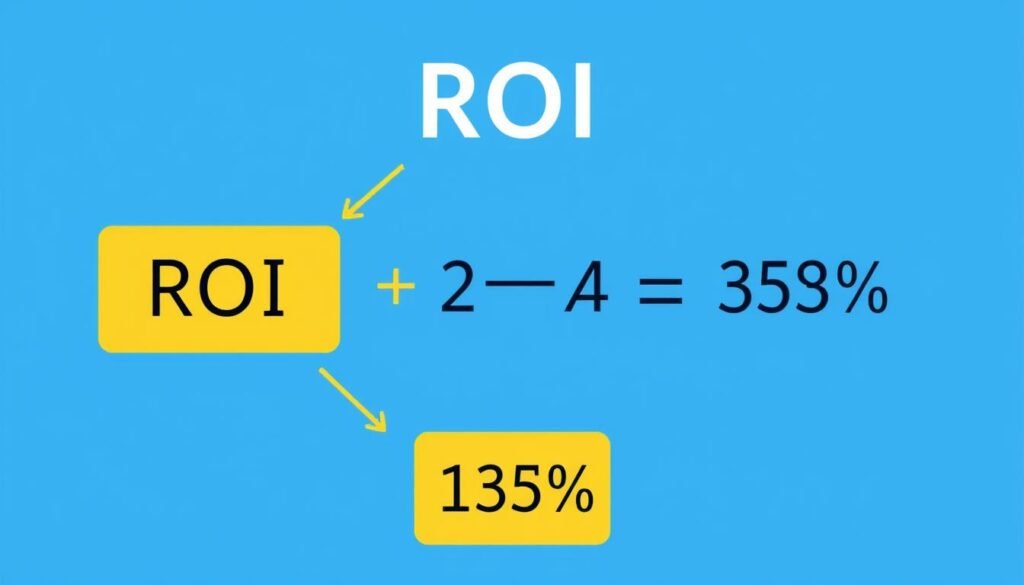
Annualized ROI Formula
When comparing investments held for different time periods, it’s more accurate to use the annualized ROI formula:
Annualized ROI Formula:
Annualized ROI = ((1 + ROI) ^ (1 / n) – 1) × 100%
Where n = number of years the investment is held
For instance, if your investment achieved a 50% ROI over 5 years, the annualized ROI would be:
Annualized ROI = ((1 + 0.5) ^ (1 / 5) – 1) × 100% = 8.45%
This means your investment grew at an average rate of 8.45% per year.
Calculate Your ROI Now
Stop manually calculating complex ROI formulas. Use our calculator to get instant results.
Types of ROI Calculations
Different situations call for different approaches to calculating ROI. Here are the most common types of ROI calculations used across various industries and investment scenarios:
Financial Investment ROI
Used for stocks, bonds, real estate, and other financial assets. This calculation focuses on the direct monetary return from capital appreciation and income.

Marketing ROI
Measures the effectiveness of marketing campaigns by comparing the revenue generated against the cost of marketing activities.

Business Operations ROI
Evaluates the return on investments in equipment, technology, or process improvements within a business.

Specialized ROI Metrics
| ROI Type | Formula | Best Used For | Limitations |
| Social Media ROI | ((Value of Conversions – Cost of Campaign) / Cost of Campaign) × 100% | Evaluating social media marketing effectiveness | Difficult to attribute direct sales to social media efforts |
| Employee Training ROI | ((Value of Productivity Increase – Training Cost) / Training Cost) × 100% | Justifying workforce development investments | Challenging to quantify exact productivity improvements |
| IT Project ROI | ((Value of Benefits – Project Cost) / Project Cost) × 100% | Evaluating technology investments | Benefits may be partially intangible or long-term |
| Customer Acquisition ROI | ((Customer Lifetime Value – Customer Acquisition Cost) / Customer Acquisition Cost) × 100% | Measuring sales and marketing efficiency | Requires accurate lifetime value predictions |
How to Use an ROI Calculator Effectively
Our ROI calculator simplifies the process of evaluating investment performance. Follow these steps to get the most accurate results:
- Determine your initial investment amount
Include all costs associated with the investment, such as purchase price, fees, taxes, and maintenance costs.
- Calculate the total return
Add up all income and gains from the investment, including dividends, interest, rental income, and appreciation in value.
- Enter the investment period
Specify how long you’ve held or plan to hold the investment to calculate annualized returns.
- Review both standard and annualized ROI
Compare both metrics to get a complete picture of investment performance, especially when evaluating investments with different time horizons.
- Compare against benchmarks
Evaluate your ROI against relevant industry benchmarks or alternative investment opportunities.
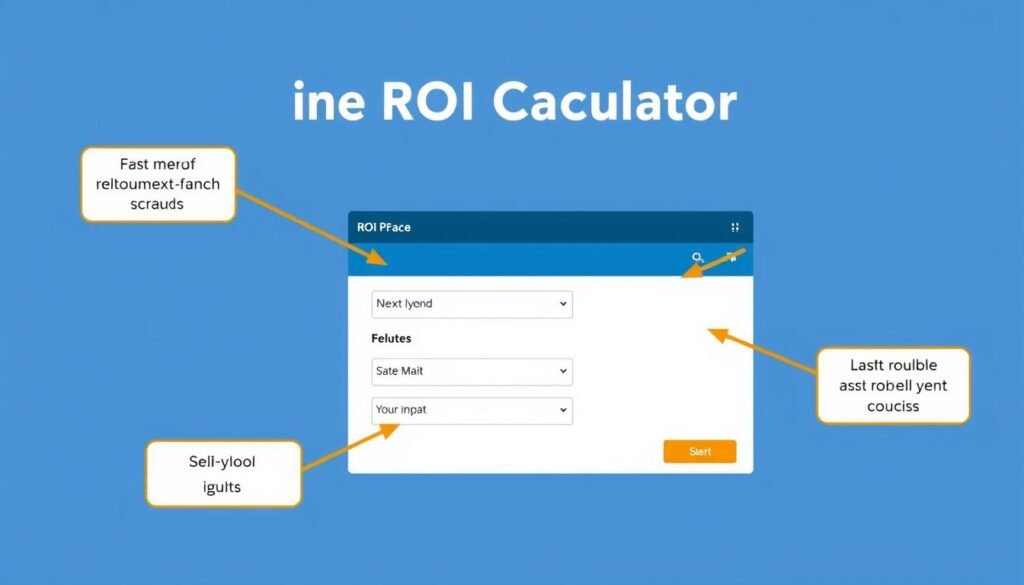
Ready to Calculate Your ROI?
Stop guessing about your investment performance. Get precise ROI calculations in seconds.
Real-World ROI Calculation Examples
Understanding how to apply ROI calculations to different scenarios helps clarify the concept. Let’s explore some practical examples:
Example 1: Stock Investment ROI
Imagine you purchased 100 shares of a company at $50 per share ($5,000 total investment). After two years, you sell all shares at $65 each, receiving $6,500.
ROI Calculation:
ROI = (($6,500 – $5,000) / $5,000) × 100% = 30%
Annualized ROI = ((1 + 0.3) ^ (1/2) – 1) × 100% = 14.02%
Example 2: Marketing Campaign ROI
Your company invests $20,000 in a digital marketing campaign. The campaign generates $120,000 in attributable sales over six months.
ROI Calculation:
ROI = (($120,000 – $20,000) / $20,000) × 100% = 500%
Annualized ROI = ((1 + 5) ^ (1/0.5) – 1) × 100% = 1,600%
Example 3: Real Estate Investment ROI
You purchase a rental property for $300,000. After five years, you sell it for $400,000. During ownership, you earned $100,000 in rental income and spent $50,000 on maintenance, taxes, and insurance.
ROI Calculation:
Total Return = $400,000 (sale price) + $100,000 (rental income) – $300,000 (purchase price) – $50,000 (expenses) = $150,000
ROI = ($150,000 / $350,000) × 100% = 42.86%
Annualized ROI = ((1 + 0.4286) ^ (1/5) – 1) × 100% = 7.4%
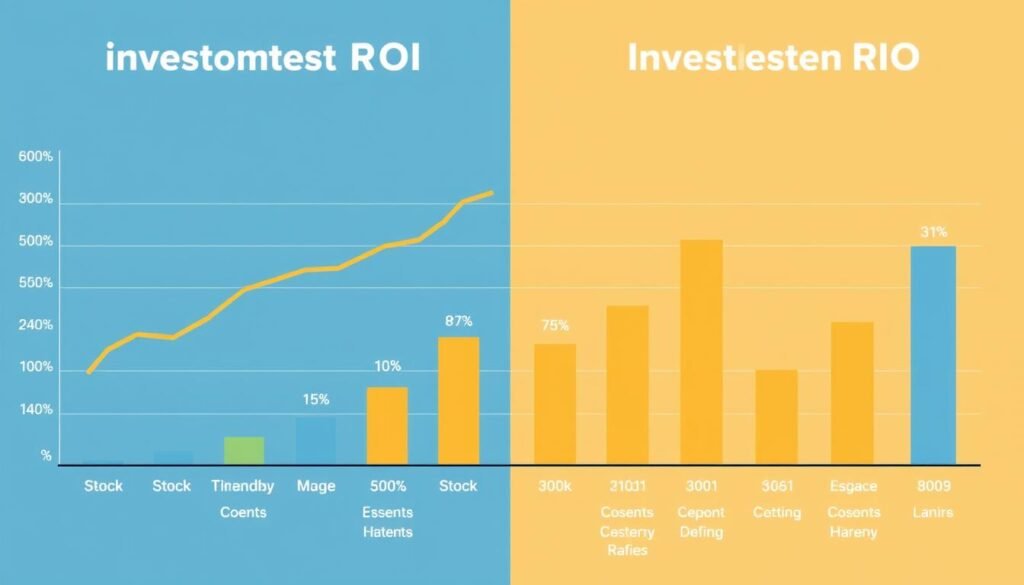
Limitations and Considerations of ROI Calculations
While ROI is a valuable metric, it has several limitations you should be aware of when making investment decisions:
Advantages of ROI
- Simple to calculate and understand
- Universally recognized financial metric
- Allows easy comparison between different investments
- Provides clear performance measurement
- Helps justify business decisions with quantifiable data
Limitations of ROI
- Doesn’t account for time value of money in basic form
- May not include all relevant costs (hidden expenses)
- Doesn’t factor in risk assessment
- Can be manipulated by changing which costs are included
- Doesn’t capture non-financial benefits or impacts
Important Factors Not Captured by ROI
Risk Assessment
ROI doesn’t indicate the level of risk associated with an investment. Two investments might have identical ROI projections but vastly different risk profiles.
Liquidity Considerations
The ROI calculation doesn’t reflect how easily you can access your money. Some high-ROI investments may lock up capital for extended periods.
Time Value of Money
Basic ROI doesn’t account for inflation or the opportunity cost of capital over time. For long-term investments, metrics like Net Present Value (NPV) may be more appropriate.
Qualitative Benefits
Many investments produce benefits that aren’t easily quantifiable, such as improved brand reputation, employee satisfaction, or strategic positioning.
Pro Tip: When evaluating investments with different time horizons, always use annualized ROI rather than standard ROI for more accurate comparisons.
ROI Benchmarks: What’s a Good Return on Investment?
Understanding what constitutes a “good” ROI depends on various factors including industry standards, risk levels, and alternative investment opportunities. Here are some general benchmarks to consider:
| Investment Type | Average Annual ROI | Risk Level | Typical Time Horizon |
| Stock Market (S&P 500) | 10-11% | Moderate to High | 5+ years |
| Real Estate | 8-12% | Moderate | 5-10+ years |
| Bonds | 4-6% | Low to Moderate | 1-10 years |
| Marketing Campaigns | 200-800% | Varies Widely | 3-12 months |
| Business Equipment | 15-30% | Moderate | 3-7 years |
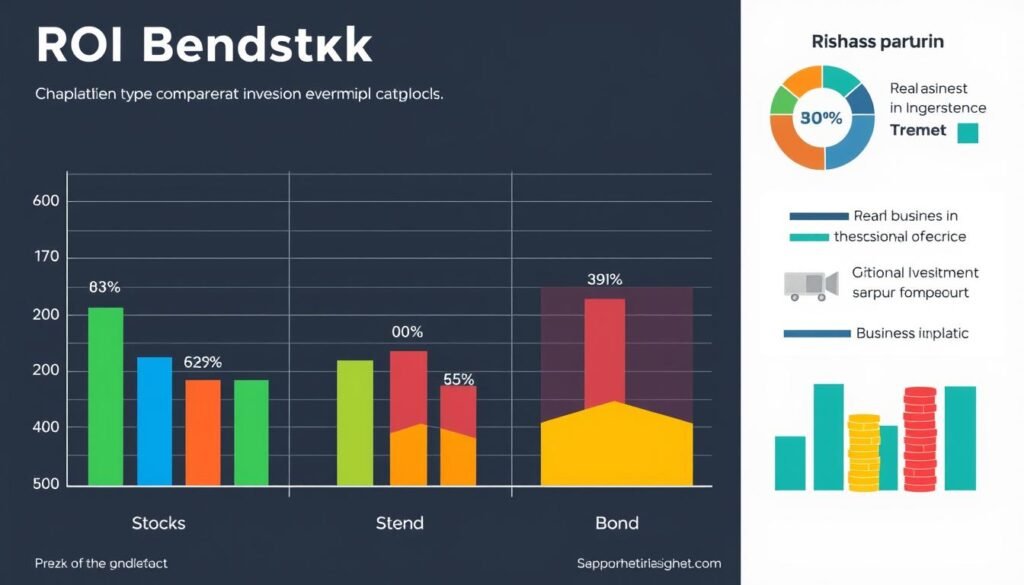
Factors That Influence “Good” ROI Thresholds
Risk Tolerance
Higher-risk investments should offer higher potential ROI to compensate for increased uncertainty. Your personal or organizational risk tolerance will determine acceptable ROI thresholds.
Opportunity Cost
A “good” ROI should exceed what you could earn from alternative investments with similar risk profiles. Always compare potential investments against your next best option.
Industry Standards
Different industries have different ROI expectations. Technology investments might target 30%+ ROI, while infrastructure improvements might aim for 15-20%.
Common ROI Calculation Mistakes to Avoid
Even experienced investors and business professionals can make errors when calculating ROI. Here are the most common mistakes to watch out for:
- Overlooking hidden costs
Many ROI calculations fail to include all relevant expenses such as transaction fees, taxes, maintenance costs, or opportunity costs.
- Ignoring the time factor
Using standard ROI to compare investments with different time horizons can lead to misleading conclusions. Always use annualized ROI for time-sensitive comparisons.
- Failing to account for risk
Two investments with identical ROI projections may have vastly different risk profiles. Higher-risk investments should demand higher ROI potential.
- Using inconsistent measurement periods
When comparing multiple investments, ensure you’re using the same time periods for measurement to avoid skewed results.
- Confusing ROI with other financial metrics
ROI is sometimes confused with metrics like Return on Equity (ROE), Return on Assets (ROA), or Internal Rate of Return (IRR), which measure different aspects of financial performance.
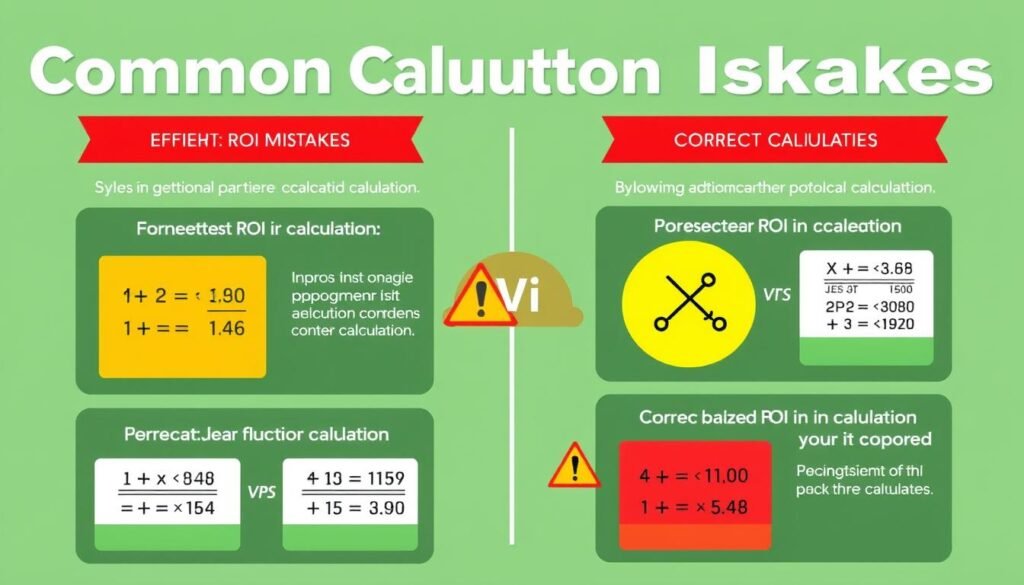
Warning: Inaccurate ROI calculations can lead to poor investment decisions. Always double-check your inputs and consider consulting with a financial professional for complex investment scenarios.
ROI vs. Other Financial Metrics
While ROI is valuable, it’s often used alongside other financial metrics for comprehensive investment analysis. Understanding how ROI compares to these metrics helps you choose the right tool for your specific needs:
| Metric | Formula | Best Used For | Compared to ROI |
| Return on Equity (ROE) | Net Income / Shareholder’s Equity | Measuring company profitability relative to equity | Focuses specifically on returns to shareholders rather than total investment |
| Return on Assets (ROA) | Net Income / Total Assets | Evaluating how efficiently a company uses its assets | Measures profitability relative to all assets rather than specific investments |
| Internal Rate of Return (IRR) | Discount rate that makes NPV = 0 | Complex investments with variable cash flows | Accounts for time value of money and irregular cash flows |
| Payback Period | Initial Investment / Annual Cash Flow | Determining how quickly an investment returns its cost | Focuses on time to recoup investment rather than total return |
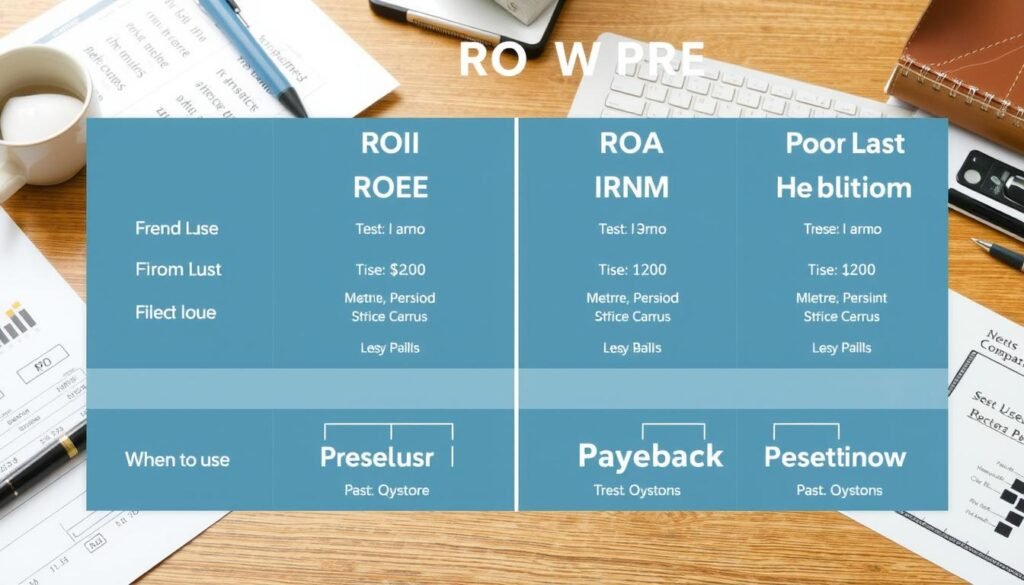
For comprehensive investment analysis, consider using ROI in conjunction with these complementary metrics to get a more complete picture of potential performance.
Frequently Asked Questions About ROI Calculators
What is a good ROI percentage?
A “good” ROI depends on factors like industry, risk level, and available alternatives. Generally, stock market investments average 10-11% annually over the long term. Real estate typically returns 8-12%, while bonds offer 4-6%. For business investments, 15-30% is often considered good. Higher-risk investments should yield higher ROI to compensate for increased uncertainty.
How is ROI different from profit?
Profit is an absolute number representing the difference between revenue and costs (Revenue – Costs = Profit). ROI is a ratio that shows the efficiency of an investment by comparing profit to the investment cost ((Profit / Investment Cost) × 100%). While profit tells you how much money you made, ROI tells you how efficiently your investment generated that profit.
Can ROI be negative?
Yes, ROI can be negative when an investment loses money. A negative ROI indicates that the final value of the investment is less than the initial cost. For example, if you invest
Frequently Asked Questions About ROI Calculators
What is a good ROI percentage?
A “good” ROI depends on factors like industry, risk level, and available alternatives. Generally, stock market investments average 10-11% annually over the long term. Real estate typically returns 8-12%, while bonds offer 4-6%. For business investments, 15-30% is often considered good. Higher-risk investments should yield higher ROI to compensate for increased uncertainty.
How is ROI different from profit?
Profit is an absolute number representing the difference between revenue and costs (Revenue – Costs = Profit). ROI is a ratio that shows the efficiency of an investment by comparing profit to the investment cost ((Profit / Investment Cost) × 100%). While profit tells you how much money you made, ROI tells you how efficiently your investment generated that profit.
Can ROI be negative?
Yes, ROI can be negative when an investment loses money. A negative ROI indicates that the final value of the investment is less than the initial cost. For example, if you invest $1,000 and end up with $800, your ROI would be -20%, indicating a 20% loss on your investment.
How often should I calculate ROI for my investments?
For long-term investments like retirement accounts or real estate, annual ROI calculations are typically sufficient. For more active investments like stocks or business projects, quarterly reviews may be appropriate. Marketing campaigns might require monthly or even weekly ROI analysis. The frequency should match your investment strategy and time horizon.
Why does my ROI calculator give different results than manual calculations?
Differences may occur because calculators often include factors that manual calculations might miss, such as compounding effects, reinvested dividends, or annualization adjustments. Some calculators may also automatically account for fees, taxes, or inflation that you might not have included in manual calculations. Always check which methodology and assumptions are being used by the calculator.
,000 and end up with 0, your ROI would be -20%, indicating a 20% loss on your investment.
How often should I calculate ROI for my investments?
For long-term investments like retirement accounts or real estate, annual ROI calculations are typically sufficient. For more active investments like stocks or business projects, quarterly reviews may be appropriate. Marketing campaigns might require monthly or even weekly ROI analysis. The frequency should match your investment strategy and time horizon.
Why does my ROI calculator give different results than manual calculations?
Differences may occur because calculators often include factors that manual calculations might miss, such as compounding effects, reinvested dividends, or annualization adjustments. Some calculators may also automatically account for fees, taxes, or inflation that you might not have included in manual calculations. Always check which methodology and assumptions are being used by the calculator.
Making Informed Decisions with ROI Calculations
Return on Investment calculations provide valuable insights for evaluating investment opportunities and measuring performance. By understanding how to properly calculate and interpret ROI, you can make more informed financial decisions and optimize your investment strategy.
Remember that while ROI is a powerful metric, it works best when used alongside other financial indicators and with a clear understanding of its limitations. Always consider factors like risk, time horizon, and opportunity costs when evaluating potential investments.
Start Calculating Your ROI Today
Make smarter investment decisions with accurate ROI calculations. Our free calculator gives you the insights you need in seconds.
Pingback: Margin Calculator: Calculate Profit Margin, Markup & Gross Margin